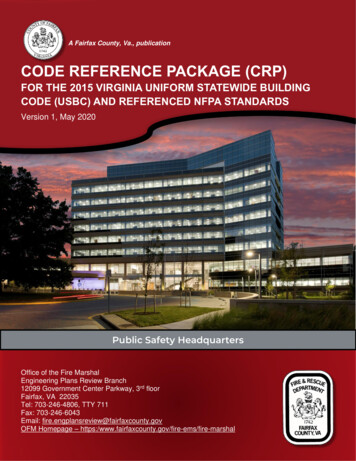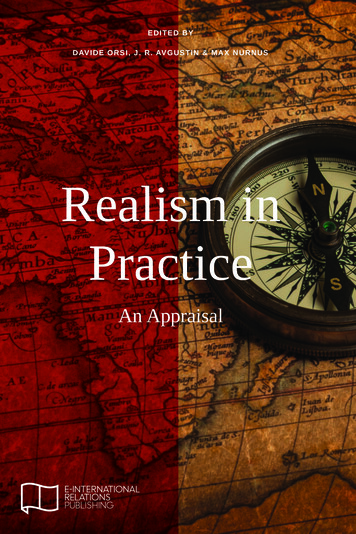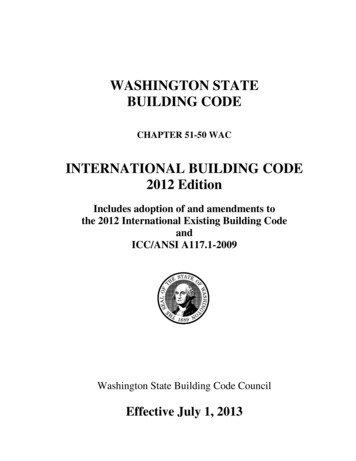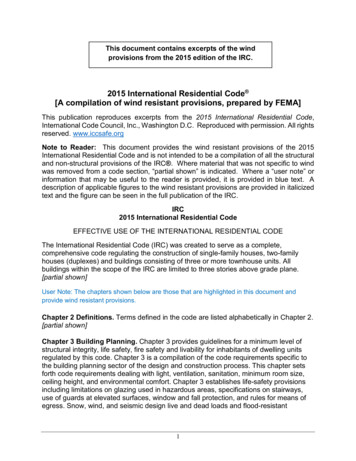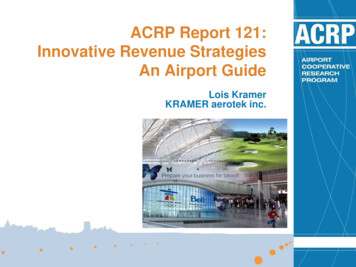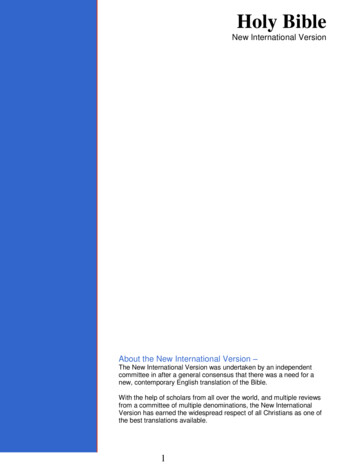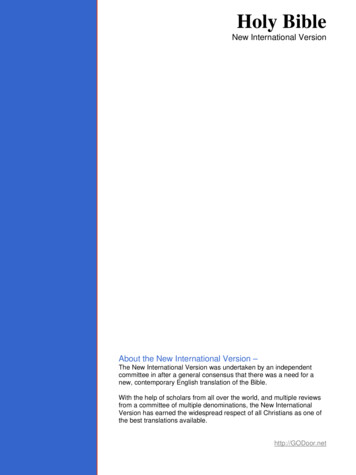
Transcription
Q i
TABLE OF CONTENTSLISTOF ABBREVIATIONSFOREWORDPREFACE.SECTIONvxxiONE: BIBLICAL CONSIDERATIONSCHAPTER ONE: ANGELS AND DEMONS IN THEOLD TESTAMENTIntroduction.2Angels and Demons in the Pentateuch . 2Angels and Demons in the Historical Books . i3Angels and Demons in the Wisdom Narratives . 16Angels and Demons in the Prophets.!9CHAPTER TWO: ANGELS AND DEMONS IN THE NEWTESTAMENT HISTORICALBOOKSIntroduction.Angels and Demons in Matthew .2727Angels and Demons in Mark .Angels and Demons in Luke .3238Angels and Demons in John .Angels and Demons in Acts . :.4143CHAPTER THREE: ANGELS AND DEMONS IN THENEW TESTAMENT EPISTLESAngels and Demons in the Pauline Epistles .47Angels and Demons in the General Epistles .Angels and Demons in Revelation .6269v
Permissionsfor QuotationsTHEWORLD OFTHE SPIRITSA Biblical Study in the African ContextScripture taken from the NewAmerican Standard Bible, copyright 1960,1962, 1963,1968, 197I, 1972, 1973, 1975, 1977 by the Lockrnan Foundation. Usedby permission. Copyright1990 by A. Scott Moreau"Ancestor Relations among Three African Societies in Biblical Perspecfive" by Richard J. Oehman, copyright @ 1985, used by permission of the author.All rights reserved. Printed in KenyaBiblical Interpretation and the Church, edited by D. A. Carson, copyright@ !984, The Patemoster Press, Ltd, Exeter, UK, used by permission.Angels and Demons by Mrs. George C. Nceham, @ no date, Moody BibleInstitute of Chicago. Moody Press. Used by permission.No part of this book may bereproduced, stored in a retrieval system,or 2nsmitted in anyfo n or by any means,electronic, mechanica!, photocopying, recordingor otherwise, without the prior written permissionof the publisher and/or the author.A gels Watching Over Me by Betty Malz, copyright 1986, HodderStoughton Limited, Kent, UK, used by permission.andBiblical Interpretation and the Church, edited by D. A. Carson, copyright 1984, The Paternoster Press, Ltd, Exeter, UK, used by permission."v" by John Richards,Longman & Todd, Ltd, London, used by permission.copyright@ 1974, Darton"Clinical Testing Technique" by Tom White, copyright @ 1984, by permission of the author.Counseling and the Demonle by Rodger Bufford, copyright 1988, WordIncorporated, Dallas, Texas, used by permission.ISBN9966-850-91-0The First Letter of Paul to the Corinthians by Samuel Oyinloye Abogunrin,copyright @ 1988, Uzima Press, Nairobi, Kenya, used by permission.t aJing by Francis MacNutt, copyright 1974 by Ave Maria Press, NotreDame, IN 46556 (all rights reserved), used with permission of the publisher.The Holy Spirit and You by Dennis and Rka Bennett, copyright @ 1987,by permission of Kingsway Publications Ltd, 1 St Anne's road, Eastbourne, EastSussex, England.Jude. 2 Peter by Richard J. Bauckhana, copyrightporated, Dallas, Texas, used by permission. 1983, Word Incor-Satan is No Myth, by J. Oswald Sanders, copyright @ 1975, Moody BibleInstitute of Chicago. Moody Press. Used by permission.Si -ns and Wonders Today by Donald Bridge,Varsity Press, Leicester, UK. Used by permission.ublished bygVANGELPUBLISHINGHOUSE,wVTBAG 28963, NAIROBI, KENYAPrz'nted byUNI-TRADEPRINTERSBOX 52361, NAIROBI,109876LTD.2@ 1985, Inter-"Spiritual Warfare Bootcamp" by Tom White, copyright @ 1984, by permission of the author.KENYA,543copyrightiii
CHAPTER FOUR: TOWARDS A BIBLICAL WORLD VIEWintroduction .Realms ill the Universe .Questions for Further Reflection7979The Ftmcfions of Spirit B 'mgs .Towards a Theology of Demonic SpMtual Warfare .Conclusion .818496Questions for Further Reflection98.CONCLUSION:TOWARD A CHRISTIAN100The Spirit Realm in Traditional Africa .Wltclicraft and Sorcery in Traditional Africa .102108Protection from the Supernatural .Functions of the Occult in Traditional Africa .The Modern Scene .Conclusion .113115124127Questions for Further Reflection128.Personal ProtectionBIBLIOGRAPHY195OF CITED SOURCES130from Demonic Attack .130Ministering to the Demonically Oppressed:A Suggested Counselling Procedure .Conclusion .3.32162CHAPTER SEVEN: TOWARD AN U1NDERSTANDING OF THEMINISTRY OF ANGELS IN AFRICA TODAYIntroduction .3.63The Biblical Data for Understanding theRole of Angels in Today's World .165Toward a Methodology of EvaluatingSupernatural Manifestations.J.69Fur ther Consideratinns about Angels in Africa . 181Conclusion .185vi. 188191SECTION THREE: APPLICATIONCHAPTER SIX: DEALING WITH THE DEMONICIntroduction .RESPONSE186APPENDIX: LISTING OF THE GREEK TERMS OF DEMONICATTACK REFERRED TO IN THE TEXT .SECTION TWO: AFRICAN CONSIDERATIONSCHAPTER FIVE: THE SPIRIT REALM INSUB-SAHARAN AFRICAIntroduction: Foundational Issues .vii.
LIST OF ABBREVIATIONSNICOTNIDNTT New International New InternationalNIGTCNIV The New International Greek Testament Commentary New International VersionNLCNTb!T New London Commentary New TestamentOTRSV Old Testament Revised StandardTCTDNT ThornappleAB Anchor BibleBAG Bauer, Arndt, Gingrich, and Danker's Greek-EnglishLexiconTDNT AbridgedBDBBEP Brown, Driver, and Briggs' Hebrew-EnglishTDOTTNTCTOTCBKC(OT)Lexicon Baker's Encyclopedia of Psychology BibIe K owledge Commentary (Old TestamentTWOTWBCcNTc literally "against", it means "as opposed to; indisa eement with" Calvin's New Testament CommentariesEBC Expositor's Bible CommentaryEDT Evangelical Dictionary of Theology The Expositor's Greek Testament For the Latin ibidem, "in the same place", meaning thesame reference as cited previouslycontraEGTIbid.ICCIDBISBE RevisedY-JVLXXMM The International The Interpreter's The Internationaled. (1979)Critical CommentaryDictionary of the BibleStandard Bible Encyclopedia,WSZPEBCommentary on the Old TestamentDictionary of New Testament TheologyVersionCommentaries Theological Dictionary of the New Testament Theological Dictionary of the New Testament, Abridgedin one volume Theological Dictionary of the Old Testament Tyndale New Testament Commen taxies Tyndale Old Testament Commentaries Theological Wordbook of the Old Testament Word Biblical Commentary Word Studies (Wuest) ZondervanPietoral Encyc!opediaRevised King James Verslon Septuagint Moulton and Milligan (The Vocabulary of the GreekT e aam )NASBNBDNCBCNDTNEBNICNT New American StandardBible New BibIe Dictionary New Century Bible Commentary New Dictionary of Theology New English Bible New International Commentaryviiion the New Testamenton the New Testamentixof the Bible
PREFACEFOREWORDOne of the great failures of missionary work in general and theologicaleducation in particular has been to relate Christian theology to the Africancontext at a functionallevel. We have lamented the syncretism practiced by manyAfrican believers, but we have not recognized our own syncretism. Since we comefrom the secular/sciantlllc end of the spectrum of belief systems, our syncretismis respectable in the West because it is an accommodation to the sectflar educational establishmentto which we look for academic respectabilityandaccreditation.Scott Moreau is to be commended for his pioneering work in relatingangelology to the African concepts of the spirit world. It is unusual to find aWesterner who takes the idea of evil spirits seriously as a factor in everyday life.We can speculate about them in our theological discussions and write about themin theological treatises, but we ascribe a minimum of causation to them whenlooking for explanations for the events of life. The African, however, has traditionally ascribed a maximum of causation to the spirit world. Both positions areat variance with the biblical position, and this book helps to bring us to the balancepoint on this subject.It is imperative that we distinguish between a belief system held at anindividual level and a belief system by which we live our daily lives. There is oftena considerable gap between these two. In the religious realm the latter is spokenof as "folk religion." Christianity must operate at the leve! of folk belief syste m.sor it becomes irrelevant to where people really hve. The laeas expressea m thisbook must be lived out if they are to make an impact on African church life. Theymust be taken out of the classroom to the homes and villages. May God be pleasedto use this work to spark revival in the African church as the power of God isdemonstrated in the spirit realm rather than just being talked about.Timothy M. WarnerTrinity Evangelical Divinity School6 March 1990In teachingwas drawn by thecombination withtually this becamea class on angelology over the past several years, our attentionfact that there is no clear presentation of the biblical data inan examination of the African scene available in print. Eventhe motivation for this book.Before we describe our approach, however, our philosophical foundationshould be noted. Without apology or defense, we presuppose that the Bible isGod's written word to man, fully authoritative and eternally and universallyrelevant in all that it teaches and affirms. Within the framework of that presupposition, we consider contextualisationto be the application of the whole of thebiblical data to the whole of the context, with the biblical data serving as the"normative" foundation and the contextual factors serving as the "relative" arenain which the norms are applied. Other terms which are important to this studyare angelology and spirit realm. By angelo ogy, we refer to the study of all thebiblical types of angels (or spirits), whether evil or good. The spirit realmincludes not only the spMts per se, but also any occultic phenomena, phenomenawhich makes use (or claims to make use) of abnormal or supernatural powers.This book is as much a work of methodology as it is of content, as will (wehope!) be clear to the careful reader. With that in mind, we turn to a brief, butnecessary, presentation of the "layout" of the material. The book is divided intothree major sections, with a set of ten questions for further reflection and studyat the end of each section. The appendix gives a listing of all the Greek termsused for demonic attack on and Christian ministry to the oppressed.This isintended for the student who wishes to do a more intensive vocabulary study thanwe have presented in the book.In section one, we have sought to present the biblical world view regardingthe spirit realm. The major portion of this section is devoted to presenting, asconcisely as possible, discussion on all of the biblical passages which are necessaryfor the development of a biblical angelology. Quite frankly, the discussion in thefirst three chapters may be skipped if the reader is not interested in seeing thebreadth of the scriptural data. if the reader does choose to study these chapterscarefully, however, an open Bible is indispensable. PIease note that the discussionis as abbreviated as possible--we have tried to note differing interpretations whenx1X
they are important to the topic, but generally have done our best to avoid extendeddiscussion on each passage. We hope that the material in section one wlU serveas a"data base" for future readers, at least saving them the work of sorting throughthe entire Bible to find the passages germane to the topic of angelology.With the foundation of the biblical data base thus established, in chapterfour we seek to present one possible organisation of the data in the framework ofthe African setting. We have purposely kept the discussion in this section asbroadly based as possible, recognising the danger that we may very well be toobroad to be applicable in any one particular setting (or among any one particularpeople). Our purpose was not to attempt to provide any type of"defmltlve" work,but to cut a methodological path which others, better versed in a particularcontext, wil! be able to follow for their people and their setting. In that sense, thebook is as much one of a proposed method of coutextualisationas it is of thecontent of the proposed "contex'tualised" material. Further, while we do notconsider that wc have exhausted the possible topics and areas which could bediscussed (e.g., the history of angelology in the West), we have tried to approachissues and ideas of relevance, significance, and interest to a general (and not oulya "theological") audience.In section two, we attempt to give a broad panorama of the African viewsand feelings on the spirit realm. The picture is purposefully ovcrgencralised inthe hopes that others, working with particular peoples, will be able to utiliserelevant sections in the discussion to develop their own arigclologlcal approachwithin their own contexts.In section three, we present an application of the biblical data to that ofthe cultural framework in two arenas of angelology: ministering to those who aredemonically oppressed, guldefines for evaluating apparent "angelic" manifestations, and understanding the continuing role of angels in Africa today.Our hope is that this book will be consider ed usable in a classroom setting.In our own classroom approach, we spend approximately half of our time in thebiblical section, and half in the world view and application sections. If used as atext, one major assignment for the students could be the development of theirown "systematic" approach based on the biblical data (to be turned in before wedeal with the application section in class!).We should also briefly mention the format used for the parentheticalreference notes. In them, we give the author's surname, an abbreviated title ofthe work cited, and the page number. The interested reader will find all the citedworks in the bibliography, which is orgaulsed by sections in the same chapterarrangement as the book.Finally, a word of acknowledgement. Many thanks are due to Dr. TimothyWarner, who has greatly stimulated my thinking in this whole area, and to the staffand administration of the Nalrobi International School of Theology, who haveprovided me with the opportunity to take my missiological approach into thexiitheology classes taugJat at the school. Special thanks go to Jackson Ngalyuka,Abraham Kasika, Benjamin Mtrsyoka, Paul Bowers, and Sam Oweu for readingthe manuscripts and making several valuable (and incorporated) suggestions, andto Mike Packard for helping set this up for publishing. All remaining deficiencies,however, are my responsibifity alone. Finally, my greatest thanks go to my wife,Emily, who has graciously tolerated too many hours of "computer widowhood"while I was glued to a screen with this work.A. Scott MoreauMarch, 1990
78reminder that human and celestial will occupy that dry together (Beasley-M ra?,p.321).Revelation 21:17 Angelicmeasurements axe the same as huma measurements. This may serve as a reminder that human and diane vA.11be combined it,the New Jerusalem (Johnson, "Revelation", p. 596), that men and angels are"fellow servants" (19:10), and that we will someday be hke angels (Luke 20:34-6;Swete,p. 290).CHAPTERFOUR:TOWARDS A BIBLICALWORLDVIEWIn this chapter, we will present a prelh arydlseussion of the major issuesinvolved in developing a biblical world view of angelology. Our hope is that thiswill point us in the right direction of developing a better understanding of thespk,Stual dynamics of the universe which God has created. At the outset, however,we should note the dangers of seeking to construct a systematic world view fromthe biblical data. Writing of principalities, powers, rulers, etc. The New Testament nowhere gives us a systematic treatLse--the primary concern is that angelsare servants of God who minister to believers and that demons are spirits whooppose God and must be opposed by the believer.It appears not to be asconcerned with the philosophy of the world as the reality of the spiritual battlethat the believer will constantly encounter (Schlier,pp. 13-14).Reatms in the UniversgOne important component of biblical angeIology is that of the nature ofthe universe itself. The biblical data gives hints of three major "spheres ofoperation" in the universe. These areas cannot be completely separated, thougheach appears distinctly and can be discussed separately (just as water, land, andair axe all part of the earth but axe distinct and can be discussed individually).The Realm of God's Throne and AngelsThe first sphere of operation is the realm of God's throne and His angels.Th realm should not be thought of as being a literal physical place. Rather, it isthe realm where God's rule is exercised openly and visibly: "Throne' here denotesis.overnment. The point is not Rat heaven is God's location, but that it expressesabsolute and inviolable lordship." (Tranb, "Ouranos", TDNT Abridged). God . .:.,. ., .
8OHimself, of course, is confined to no realm. Even the "heaven of hea:,e s' ca e ".tcontain Him (1 Kings 8:27); He {s above all re 1alms (Malt. 5:34, Hob. 3:1).Likewise, Christ is not limited; He ascended far above nil the heavens (Eph. 4:10;cutup. Hob. 4:14).This is a realm created by God (Neh. 9:6)wherethe gels pz-e cxthemselves to Him (Job 1:6 and 2:1). It probably includes the heaven of heave ;.es(ifit is separate from the heavens; Neh. 9:6). It maya!so ir cl'ade the "thkd heav, (mentioned by by Paul, 2 Cur. 12:2). It is from this x'caim that Satan is cast out,but we do not know when occurs or whether Satan continues to have fir,Mtedaccess after his expulsion (see Job 1:6, 2:1, Zech. 3:1, and Roy. 12:7-9), I ha hz.znot yet been cast out, it is sfilla realm of continuing conflict, C. R. Schooakovcncontends: "The Bible depicts heaven under the wrath of God, the scene of-co cwarfare, and finally subject to dissolution prior to the creation of a new heavc.n '(Schoonhoven, "Heaven , ISBE Revised). On the other hand, l, Satan has beencast out, as others maintain, then this is "a world of pure fi at" (Bietenha.,ck"Ouranos", NIDNTT). Finally, this reaim is not eternal--it ' 'iIl be destroyed (wkhthe exception of God's throne?; ]sa. 51:6, Mark !3:3!, Hob. 1:1I-!2, 2 Pet. 3:'7)before the new heaven and new earth are created ( sa. 65:I7 and Rev. 21:1).Add of these "regions", however, appear to be subsumed in Gehenna(Davids, "Dead, Abode of the", EDT) also referred to as the lake of fire (Rev.s20:10,14, Menace,"L e of ire",EDT).ote ulpreenforalan ann ms aemons (Matt. 25:41, 46) will be thrown Hades and death (and allthe unrighteous dead, Roy. 20:14-!5)The Rea m of ManThe third sphere of operation is the realm of man, which is the physicaiworld around us. Except for unusuai ch'cumstances (e.g., John's vision on Patronswhich resulted in Revelation, Pau!'s vlslon mentioned in 2 Cur. 12), man isphysically restricted to this realm unti! death. Some, through following occulficpractices such as astral or spirit travel, claim that their spirits can leave theirphysical bodies and travel freely in the spirit realm. This is similar to some of thetraditional African beiiefs ofwltch powers (see the next chapter). Scripture doesnot teach that man has the inherent ability to naturaily and properly leave essed(v" " y o invislb/y). The mechanics of how this happens are notin Scripture and the fact that k does happen is not explained.The Realm of Spirit BeingsThe FnnetlonsThe second sphere of operation is that ofspirk beings (geacraT y evii ones).Of the three realms, we have the least amount of biblical informa o en th3s use.WhLle terms are borrowed from Judaism, the whole framework ]a never babydeveloped doctrinally the Bible. This realm may include what are called "theother two heavens" (though this designation is debatable; see Smith, H 9 D: , pp.28-39). The first of these two heavens is the air, apparently the arena of Satan'scounterfeit kingdom (Eph. 2:2). The second is the celesdai sphere (home ofplanets and stars, Gem 1:14--19; the "expanse of the sky", NIV).This realm may also include region(s) of cordmement for deraons, such asTartarus (2 Pet. 2:4, Jude 6?), the abyss (Rev. 9:1-2), and Hades (Hebrew: Shoo;):which literally means "the unseen", and refers to a shadow land of the dead(Bietenhard, "Hades", NIDNTT).The Jews of the hitertestamentperiodthought of Hades as the land of all the dead. They were separated into twocompartments,one for the righteous and one for the unrighteous (see Lee,"Hades", ISBE Revised). In the NT the picture of Hades in not fully exq z.ndedor systematically presented, and scholars debate whether it includes this partition.It is possible that, after the death and resurrection of Christ, Hades may be aregion only for the unrighteous dead (Luke 16:19-31 and Rev. 20:t3f usually beingcited as proof texts). This is explained by noting that since the death andresurrection ofChhst the righteous have gone to be w{th H inHeaven 9znmediately upon their death (Phil. 1:23; Wuest, WS, vu!. 2, "Treasures", p. 45).ofGood A ugelsWhat do good angels do? The Bible indicates that they mimster in at leasteight areas of service, each of which we briefly describe.First, they worship and praise God (Rev. 4:1-11, 5:8-14, and 7:11-12). Thiswo pand praisecontinue eternally. Unfike too many of us, they nevergrow weary of honoring our Creator!Second, they were active in ministering to Jesus during His fife on earth.Th{s mi stry ceased when He ascended to the right hand of God. Their work inthis regard included announcing His birth (Luke 2:8-15), protecting Him fromHerod (Matt. 2:13-15), ministering to Him after His temptation (Matt. 4.'!1),being ready t come to His defense ff caiIed (Matt. 26:53), announcingHisresurrection (Matt. 2.8:1-2), and reminding the disciples of the need to carry onafter His ascensdon (Acts 1:10-11).Third, they have a m stry to the saints (Heb. 1:14), seen in many area&For nstance, they are able to rescue us from trouble (Acts L2:6-I1). On specialoccasons, they surround the people of God and p otect them (2 Kings 6:15-17;Rev. 7.'3). They are sent by God to bring His messages to man (the Law, Acts7:53 and Gal. 3:t9; the birth of Christ, Luke 1:26-37; answers to prayer, Dan. 9:23;to show what must take place, Rev. 22.'6). They can hetp us physically (1 Kings
83They can interpret visions for us (when directed to do so by God, Rev.17:7). They are in some way involved in bringing our prayers before God (Rev.5:8, Rev. 8:1-5), and may carry us to heaven when we die (Luke 16:22, Jude 9).Finally, they wilt come with Christ at the time of His return, gathering the electfrom the nations (Matt. 24:31).19:7-8).Fourth, they have some control over natural forces (under the direction ofGod). We see this in the pillar of fire which led Israel out of Egypt (Num. 20:16),the earthquakes at the time of the resurrection of Christ (Matt. 28:2), the fourangels with power over the winds of the earth (Rev. 7:1), the angels with powerover fire (Rev. 14:18) and water (Rev. 16:5), and the many end-time plagues whicnthey will unleash (Rev. 6-18).Fifth, they will be directly involved in ushering in the end of the age. Theirroles include the separating of believers and unbelievers (Matt. 13:41-2), thesealing (Rev. 7:3-4) and gathering of God's saints (Matt. 24:31), the heralding ofthe judgements of the seven seals (Rev. 6:i-17; 8:1), trumpets (Rev. 8:3-9:21;11:15-19), and bowls (Rev. 15:1; 16:1-21). Perhaps the greatest role of anyparticular angel will be that of binding Satan and casting him into the abyss for1000 years (Rev. 20:1-3).Sixth, in some way they are involved in influencing the governments andnations which are currently operating under the direction of Satan (Dan. 10:20I1:1). Under God's sovereiguty, Satan temporarily has the whole world lying inhis power (1 John 5:19), but angels fight this by waging war with demons over thecontrol of nations (Dan. 10:13).Seventh, they serve as God's guards/army. As guards, cherubim and the"whirling sword" guarded the entrance to the garden of Eden (Gen. 3:24).Further, angels will guard each of the twelve entrances to the new Jerusalem (Rev.21:12). As soldiers, they (led by Michael) fight with Satan (Rev. 12:7-9), especiallywhen he seeks to overstep his boundaries (Jude 9).Eighth, and finally, bynsing the powers granted to them, they deliver God'shand of judgment on sinning believers (2 Sam. 24:15-17) and unbelievers (Gan.19; Ps. 78:49, Acts t2:3).Evi! Angels or Demonst e Origin of DemonsSatan and his demons are arrayed against Christians. When they werecreated, when they fell, how"this took place, and their organisational hierarchyare all debatedby theolo ans. Scripture does not provide a clear picture, thoughmost feel that &e evidence points towards demons being angels who fell withSatan in his rebe'flion against God (Diekason, ,p. 24). if this is the case,it appears that the demons have not lost ati of the power they had before theirfall. They seem to have the much the same powers as good angels. Unfortunately,they have given themselves and their abilities over to Satan, the "ruler of thisworld" (John 12:31, 16:11).The O rganisation o DemonsThe chief demonic ruler is Satan, a created being who chose to build adeceit rut, counterfeit kingdom in his desire to replace God as ruler of the universe.This kingdom imitates God's, as Sanders notes (see also our discussion onangelology in Revelation):Satan has his own triniV--thedevil, the beast and the false prophet(Revelation 16:13). He has his own church, a "synagogue of Satan" (Revelation2:9), hehas his own ministers, "ministers of Satan" (2 Corinthiuns 11:4-5).He has formulated his own system of theology, "doctrines of demons" (1Timothy 4:1). He has established his own sacrh einl system, "the Gentiles. sacrifice to demons" (1 Corinthians I0:20). He has his own eoramuniunservice, "the cup of demons., and the table of demons" (1Corinthians 10:21).His minsters proclaim his own gospel(s), "a gospel contrary to that which wehave preached to you" (Galatlans 1:7-8). He has his own throne (Revelation13:2) and his own worshipers (Revelation 13:4). (Sanders,pp.35-36; emphasis his)'Fne Opera :ionsof DemonsThe "service" of demons to their leader, as found ha examples in Scripture,seems to include at least four major areas of operation.The first is holdingunbelievers in bondage (Gal. 4:3), involving several activities. They are able toinvade and inhabit people, seeking to deface the image of God in them (see onMark 5:1-20). They cause some sicknesses (Luke 13:11, 16), though not all. Theyare the powers behind idols (1 Cor. 10:i9-21) and oceultic abilities (Acts 16:1618). They pretend to be ancestral or other "friendly" spirits to deceive people (2Cor. 11:15). Finally, they b ;llndthe minds of unbelievers (2 Cot. 4:3-4).The second demonic area of work is engaging believers in warfare (2 Cor.i2:7-9; Eph. 6:10-18; see the vocabulary study below). Aspects of this includebringing false doctrines and teachings (I Tim. 4:1, 1 John 4:I-4), performingmiracles and wonders to deceive many (2 Cor. 1!:14-!5; 2 Thess. 2:7-11; Rev.16:14), hindering the spread of the Gospel (1 Thess. 2:17-18), ' buffeting" believersor fighting them "hand-to-hand" (Eph. 6:12; 2 Cot. 12:7).Their third area of work appears to be controlling "nature" for Satan's use.Since angels have power over natural forces, and demons appear to be fallenangels, demons may have such go es.They may be able to use their powers tobring about "natural" disasters (hurricanes, fires, droughts, floods, typhoons,
8485tornadoes, eta ; Job 1:16, 19). The fact that a/l creation ks eagerly awaiting therevealing of the sons of God and that it wiU be set free from its slavery toc
The International Standard Bible Encyclopedia, Revised ed. (1979) King James Verslon Septuagint Moulton and Milligan (The Vocabulary of the Greek _e_aam )T New American Standard Bible New BibIe Dictionary New Century Bible Commentary New Dictionary of Theology New English Bible New



